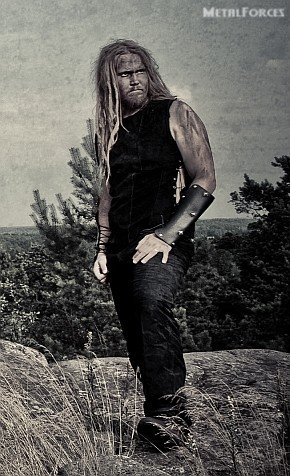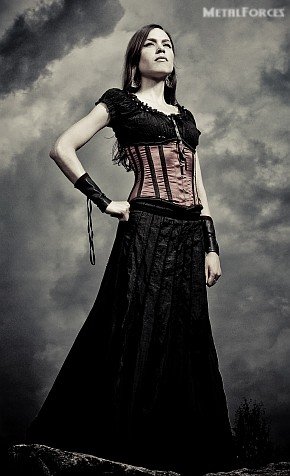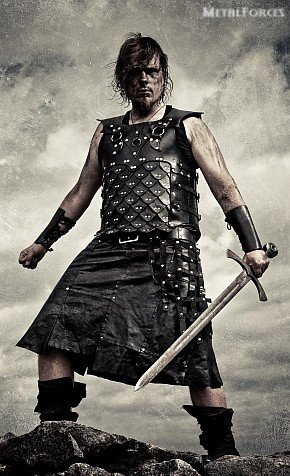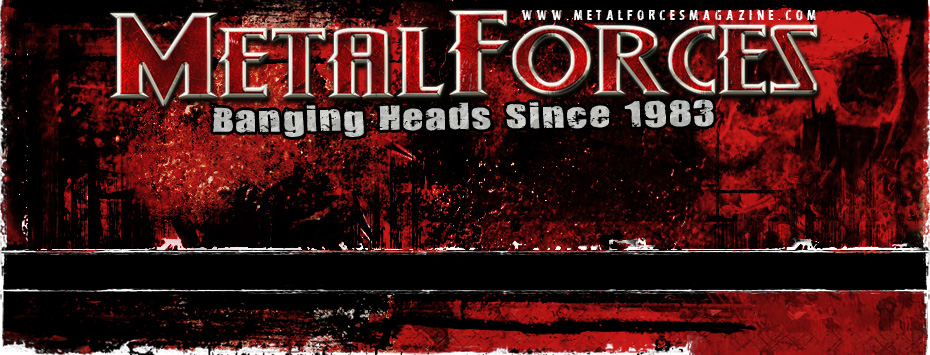
BATTLELORE – The Children Of Tolkien
Anthony Morgan
February 2011

|
Originally outlined in the 1910s, The Children of Húrin was one of many manuscripts left unfinished by fantasy author J.R.R. Tolkien. Edited posthumously by son Christopher, The Children of Húrin finally underwent publication in April 2007 – almost 34 years following Tolkien Sr.’s passing. And now almost four years after its public unveiling, the exploits of Túrin Turambar are the latest Tolkien saga to undergo the Battlelore treatment.
“About a year and a half ago we started to write new songs, so we knew that we were going to make a record,” guitarist Jussi Rautio explains. “We started to plan how to do it, but we didn’t have a clue at the beginning what to really do. There are many composers in the band so we all started to compose stuff, and then at one point somebody said ‘Let’s make a themed album’, an album completely around one theme. We then decided that the central theme would be Túrin Turambar, and he’s this tragic figure in Tolkien’s work who’s doombound. Everything that he does just goes really wrong; for example, he falls in love with sister but he doesn’t know that she’s his sister. He sleeps with her and then the sister kills herself, and in the end his character kills himself. Actually, Tolkien took this character from Kalevala which is an old Finnish book from the 1800s. It has folklore, folk stories, and there is one hero called Kullervo. Kullervo and Túrin Turambar are similar fellows; for example, in Kalevala Kullervo is talking to his sword and the sword answers him ‘I will kill you’ – Tolkien took this straight from Kalevala. Now 100 years have passed, and now we have taken this from Tolkien. We have used some Finnish lyrics for this album, and we are telling this story. In a way, we’ve completed this 100-year cycle of stories. Maybe this wasn’t so much about production and things like that, but much more about a theme. I hope it was ok though (laughs).”
To date, Battlelore’s discography consists of; …Where the Shadows Lie (August 2002), Sword’s Song (July 2003), Third Age Of The Sun (July 2005), Evernight (February 2007), The Last Alliance (September 2008), and Doombound (January 2011). The works of modern fantasy literature’s patriarch have long provided a lyrical base for the Lappeenranta, Finland epic metal outfit, and sixth studio full-length Doombound is no exception. “We have done lots of material based on Tolkien’s work of course, because in a way all of our songs can be connected to Tolkien,” the axeman comments. “In a way, we have done almost everything that can be done around Tolkien. By chance, by accident, there was this book published a little while ago by Tolkien’s son, and it’s also about Túrin Turambar – the same character. It was a coincidence because we planned to make a record about this character, and then there came a new book by Tolkien about this character. We thought ‘This was meant to be. Let’s base the album on this.’”
Was the fact that Battlelore had planned to base an album on Kullervo coincidental, or had a member of the group heard about The Children of Húrin’s existence? “Maybe we had also read somewhere that this book was coming out,” Jussi confirms. “It’s not always clear how these things come up. Sometimes when you write a song, for example, you write a very good melody or something and you’re very excited about it, and then someday you hear some other song and there’s that exact same riff. You know that you haven’t taken it on purpose, but maybe you’ve heard it somewhere before or maybe not. These things happen though.”

|
Not all fans and critics are pleased with Christopher Tolkien’s influence on his father’s posthumous material, though this is an opinion the guitarist doesn’t share. “Tolkien was an interesting fellow because he didn’t publish so much; the only books of his that were published when he was living really were The Lord Of The Rings and The Hobbit,” the Finn muses. “He made lots of these different kinds of stories, and I heard that there were millions and millions of papers he left behind. There were different stories partially written and notes about how they would have ended, but I think it’s good that Christopher Tolkien completed this book because it’s a good story. I don’t know if Tolkien himself really planned the story to be like that, but I don’t care. I still like the book, and it’s a good fantasy reading. In some ways Tolkien’s work is timeless, but in other ways it isn’t. There’s lots of fantasy writers who’ve taken his genre a little bit further. There’s plenty of good, new fantasy writers, but maybe Tolkien was the most influential one.”
These aforementioned fantasy writers “who’ve taken his genre a little bit further” would theoretically be plausible future inspirations for Battlelore, a thought the septet briefly entertained. “We talked about this once, but I think it’s not possible for us to change our lyrical inspirations anymore (laughs),” Jussi admits. “We have based roughly six albums around Tolkien’s work, so probably we’re not gonna change that. It’s interesting because in a way it’s a limitation, but if we overcome these limitations it’s much more creative. You need to be much more creative to work with some kinds of limitations, so I think we won’t take inspiration from any other fantasy writer. We will just take inspiration from Tolkien, at least in Battlelore.”
Is there enough of Tolkien’s work for Battlelore to build a career around though? “Yes. I think so because with Tolkien’s work you can take so many angles with the stories, so in a way there’s a limitless inspiration to everything. I think there’s enough of Tolkien’s work to build a career around.”
A more old-school style denotes Doombound, with fast guitars, grinding drums and so on enveloped into one package. “We were trying to create as many good songs as possible and we didn’t care about styles or genres in that sense – we just tried to create music that sounded as good as possible,” the guitarist clarifies. “As I said before, we have many composers in the band. One of us likes fast guitars, blastbeat drums and everything, so we just like to do those kind of songs. It wasn’t a conscious decision where we said ‘Let’s make this kind of record’, but more natural. Everybody can write what kind of songs they want.”
Of Doombound’s compositions, Jussi penned three. “‘Enchanted’ is my song, and so are ‘Kärmessurma’ and ‘Fate Of The Betrayed’,” Jussi reveals. “I composed the skeletons of those songs, but of course everybody’s ideas are in those songs. Maria our keyboardist is doing lots of things there, and also there were several lyrical writers for this album. I wrote some of the lyrics for ‘Enchanted’, and in a way all the lyrics for ‘Kärmessurma’. I mentioned this old book earlier called Kalevala, and some of the lyrics for that song were taken from there because they talk about killing this giant snake that can be seen as a dragon also. If you examine the album cover there is also a man killing a dragon on there, and this is something that Túrin Turambar did. But yeah, those were my songwriting contributions.

|
“I play lots of different kinds of guitar parts on the album. There are seven of us in the band so everybody cannot be in the studio at the same time, but I happen to be in the studio a lot with my friend Timo our bassist. Timo loves these walks away from the studio, and we were recording in Hämeenlinna which is in the centre of Finland. We went to some very beautiful places to play some acoustic guitars and had recording equipment, and we put some of those songs on YouTube. There were people saying ‘Are these going to be on the record? These songs sound very good’, but we didn’t put those songs on the record. They were recorded in the forest, and I think we won’t publish those songs anywhere. They can be found on YouTube, so we’ll leave it like that.”
So there are no plans to use these aforementioned tracks in a different project then? “Maybe,” the axeman chuckles. “Who knows? In our own time, we went to the forest again with some other guys and recorded some material. Actually, a little while ago we were just talking about making a kind of winter song in Finland. There’s lots of snowing – the most for the last 100 years – so it would be very beautiful to go into some forest and record some material. There are no plans, but let’s see what happens. Who knows?”
Epic, atmospheric sounds permeate Doombound, a hallmark of Battlelore’s strains. “These things are always quite hard to explain, but there are seven of us,” Jussi rationalises. “We were trying to make some very epic moments. Maria our keyboard player can also play the flute, so we used that in several songs. Also, there was a cello player (Markus Vuoristo) who played on the album. In one Finnish music newspaper, there was a story about our record where they said that some songs sound like they are meditative, and I think that’s very good. These songs are meditative, and take you to some other place. I’ve also heard some people say about how the guitar sound is very raw and very well balanced. Sonically, I think the album is very nice.”
“This album is a concept album, so that’s quite different from before,” the guitarist notes in weighing Doombound against its predecessors. “Before we were just gathering good songs and putting them together, but with Doombound we thought more about the story and everything. At first we were thinking that we should put these songs in chronological order, but then we decided that the album didn’t sound as good when the songs were in chronological order. We preferred to build the atmosphere not like a punch in your face, but something that built to something more interesting. Before we have always tried to make the album as striking as possible, but this time I think we were more focused on – in an artistic way – trying to create full-blown drama, drama that would last for the whole album. I don’t how well we succeeded (laughs), but this was our goal and this is something that we haven’t done before.”
Dual vocals are handled by Kaisa Jouhki and Tomi Mykkänen, causing a counterbalanced dynamic. “Having two singers brings a lot of opportunities because when you have two singers, you can have very long songs without them being boring,” Jussi acknowledges. “Tomi growls while Kaisa has a beautiful voice, so then we can mix those and everything. I also think two singers bring a lot of power, especially live. Because there’s two people singing at the same time, it’s much more powerful than just one. Kaisa is more female clean singing, and then Tomi is growling but still has clear vocals. Also, Kaisa has done some growling in the past so maybe we’ll also do that live. We try to mix the vocals a little bit so that it’s not so black and white.”

|
Janne Saksa (Turisas, Rotten Sound, Amoral, Omnium Gatherum) produced Doombound, while Dan Swanö (Opeth, Evergrey, Therion, Katatonia, Hail Of Bullets, Marduk) mixed and mastered. “Janne is a very talented guy of course, and he has produced lots of Finnish metal bands,” the axeman observes. “For example, Turisas is a known metal band that come from Finland. They were doing their record at the same time; when we had a weekend break these guys came to the studio and recorded something, and they left and we went back there and things like that. Janne has cool ideas for different kinds of metal and how to make metal sound good. He also has a musical background, so he’s good at laying all the instruments, singing and everything, so it’s very easy to understand his ideas. If he has an idea, he just plays it to you and then you understand what he means.
“Dan Swanö is of course a really famous guy in Sweden. I think he has done some stuff with Opeth, so it was very nice that he mixed and mastered our record. At first we were a little bit afraid, but he did the mixing and then he sent the master tapes. We listened and sent him an email saying ‘This, this and this are good things, but this, this and this are bad things.’ Surprisingly though, in the end it went very well. He made a good sound for the band, so maybe it was a good thing that we weren’t in the same room with him telling him how everything should be. He had time to himself to do everything, working alone.”
Should you wish to purchase Doombound it’s recommended you purchase its digipack version, with the package’s bonus DVD warranting special note. “It’s a big DVD; it has almost four hours of material, so it’s lots and lots of stuff,” Jussi recommends. “We have been together for ten years and this is our sixth record, so we decided to gather footage of lots of stuff that’s gone on over the years. For example, there’s different photography galleries from the year 2000 to 2010 so you can see our faces have changed in ten years, and how people have grown hair and whatever. There were two gigs recorded at Club Nosturi, and then there are also tour videos where we’ve been filmed in private, things like fooling around backstage, playing gigs and things like this. There’s lots and lots of stuff, so if you’re a Battlelore fan and you’re reading this, it’s a DVD worth watching.”
Doombound was released on January 26th, 2011 in Spain, Finland and Sweden, on the 28th in Germany, Austria, Switzerland, Benelux and Italy, on the 31st in the rest of Europe and on February 8th in North America, all through Napalm Records.
Interview published in February 2011
Related Posts via Categories
- SCOTTISH SICKNESS – A Report On The Scottish Death Metal Scene, Featuring BRAINBATH, PUTRID FATE And RANCID CADAVER (October 2022) | Features / Interviews @ Metal Forces
- LARVAE – Join The Hardcore Cult! (June 2022) | Features / Interviews @ Metal Forces Magazine
- TRENCH FOOT – Sacrificing Morals For Gory Obscenities (June 2022) | Features / Interviews @ Metal Forces Magazine
- L.A. GUNS – Trigger Happy (March 2019) | Features / Interviews @ Metal Forces Magazine
- CANCER – Crimes So Evil (November 2018) | Features / Interviews @ Metal Forces Magazine
- U.D.O. – The Tank Drives On (August 2018) | Features / Interviews @ Metal Forces Magazine
- SIEGE OF POWER – Bleeding For The Cause (August 2018) | Features / Interviews @ Metal Forces Magazine
- MOONSPELL – A Taste Of Live Eternity (August 2018) | Features / Interviews @ Metal Forces Magazine
- MONSTROSITY – Dark Matter Invocation (August 2018) | Features / Interviews @ Metal Forces Magazine
- SATAN – Five Magicians (August 2018) | Features / Interviews @ Metal Forces Magazine
|
|





